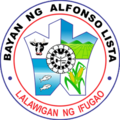Alfonso Lista Potia | |
|---|---|
| Municipality of Alfonso Lista | |
 Street in Alfonso Lista | |
 Map of Ifugao with Alfonso Lista highlighted | |
 Interactive map of Alfonso Lista | |
Location within the Philippines | |
| Coordinates: 16°55′22″N121°29′18″E / 16.9228°N 121.4883°E | |
| Country | Philippines |
| Region | Cordillera Administrative Region |
| Province | Ifugao |
| District | Lone district |
| Founded | 11 May 1955 |
| Barangays | 20 (see Barangays) |
| Government | |
| • Type | Sangguniang Bayan |
| • Mayor | Edralin B. Alipio |
| • Vice Mayor | Agapito B. Dominguez Jr. |
| • Representative | Solomon R. Chungalao |
| • Municipal Council | Members |
| • Electorate | 21,377 voters (2025) |
| Area | |
• Total | 347.46 km2 (134.16 sq mi) |
| Elevation | 142 m (466 ft) |
| Highest elevation | 1,457 m (4,780 ft) |
| Lowest elevation | 431 m (1,414 ft) |
| Population (2024 census) [3] | |
• Total | 34,810 |
| • Density | 100.2/km2 (259.5/sq mi) |
| • Households | 8,162 |
| Economy | |
| • Income class | 3rd municipal income class |
| • Poverty incidence | 9.48 |
| • Revenue | ₱ 304.3 million (2022) |
| • Assets | ₱ 526.7 million (2022) |
| • Expenditure | ₱ 240.4 million (2022) |
| • Liabilities | ₱ 74.69 million (2022) |
| Service provider | |
| • Electricity | Ifugao Electric Cooperative (IFELCO) |
| Time zone | UTC+8 (PST) |
| ZIP code | 3608 |
| PSGC | |
| IDD : area code | +63 (0)74 |
| Native languages | Ga'dang Ifugao Tuwali Ilocano Tagalog |
| Website | www |
Alfonso Lista, formerly known as Potia, officially the Municipality of Lista is a municipality in the province of Ifugao, Philippines. According to the 2024 census, it has a population of 34,810 people. [5]


